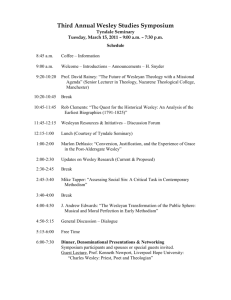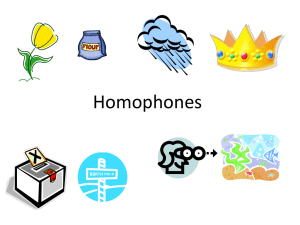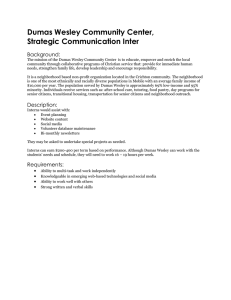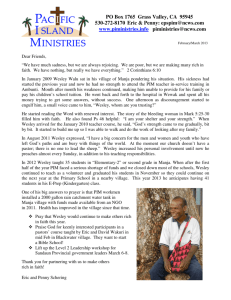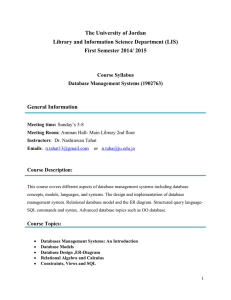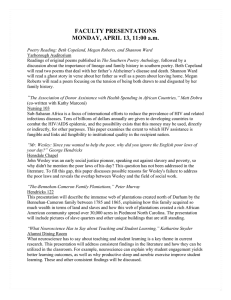Community Liaison Committee - Special Meeting Wednesday, April 27 2016
advertisement
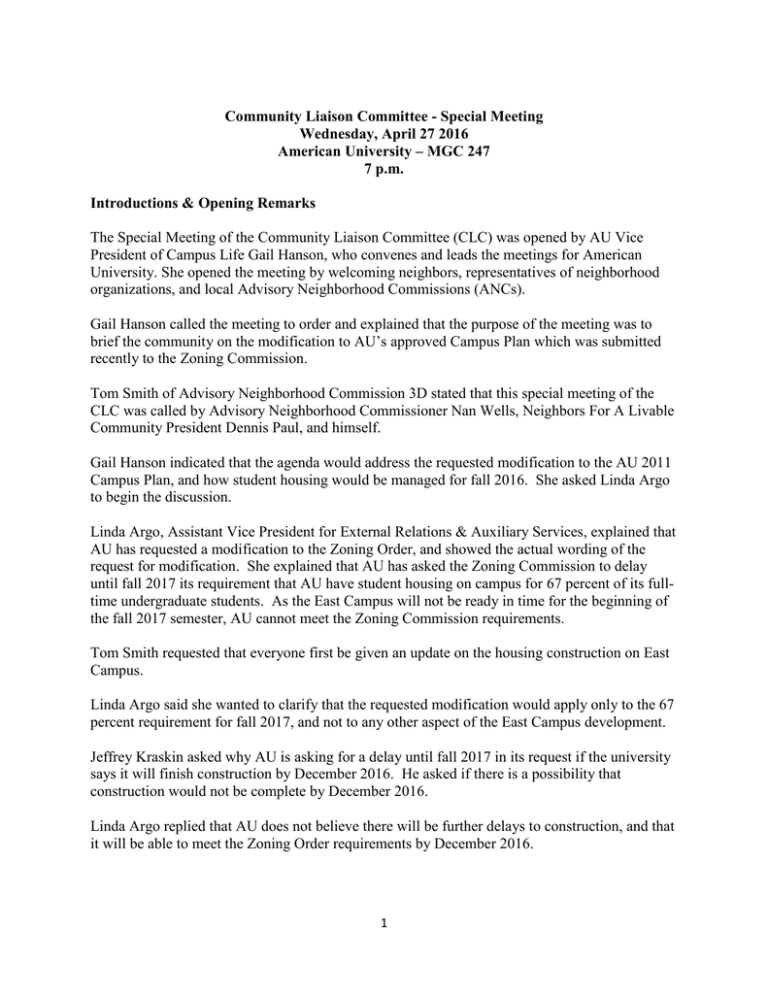
Community Liaison Committee - Special Meeting Wednesday, April 27 2016 American University – MGC 247 7 p.m. Introductions & Opening Remarks The Special Meeting of the Community Liaison Committee (CLC) was opened by AU Vice President of Campus Life Gail Hanson, who convenes and leads the meetings for American University. She opened the meeting by welcoming neighbors, representatives of neighborhood organizations, and local Advisory Neighborhood Commissions (ANCs). Gail Hanson called the meeting to order and explained that the purpose of the meeting was to brief the community on the modification to AU’s approved Campus Plan which was submitted recently to the Zoning Commission. Tom Smith of Advisory Neighborhood Commission 3D stated that this special meeting of the CLC was called by Advisory Neighborhood Commissioner Nan Wells, Neighbors For A Livable Community President Dennis Paul, and himself. Gail Hanson indicated that the agenda would address the requested modification to the AU 2011 Campus Plan, and how student housing would be managed for fall 2016. She asked Linda Argo to begin the discussion. Linda Argo, Assistant Vice President for External Relations & Auxiliary Services, explained that AU has requested a modification to the Zoning Order, and showed the actual wording of the request for modification. She explained that AU has asked the Zoning Commission to delay until fall 2017 its requirement that AU have student housing on campus for 67 percent of its fulltime undergraduate students. As the East Campus will not be ready in time for the beginning of the fall 2017 semester, AU cannot meet the Zoning Commission requirements. Tom Smith requested that everyone first be given an update on the housing construction on East Campus. Linda Argo said she wanted to clarify that the requested modification would apply only to the 67 percent requirement for fall 2017, and not to any other aspect of the East Campus development. Jeffrey Kraskin asked why AU is asking for a delay until fall 2017 in its request if the university says it will finish construction by December 2016. He asked if there is a possibility that construction would not be complete by December 2016. Linda Argo replied that AU does not believe there will be further delays to construction, and that it will be able to meet the Zoning Order requirements by December 2016. 1 Jeffrey Kraskin asked why AU is asking to delay its requirements for a full year. Linda Argo said that the Zoning Order refers to academic-year timeframes. AU elected to ask for the extension to fall 2017, but the university believes that it will meet the requirement by December 2016. AU simply chose 2017 as an academic-year marker. Tom Smith requested the update on the housing construction on East Campus. David Dower, Assistant Vice President for Planning and Project Management, reviewed the state of construction. He targeted an August 2016 completion date for Congressional and Federal Halls, and a completion date of October for Constitution Hall and the Teaching and Innovation Building (buffer buildings). He explained that Constitution Hall and the Teaching and Innovation Building would be ready for occupancy for the spring 2017 semester. Tom Smith asked when the buildings would be ready for occupancy at the earliest. David Dower replied that Constitution Hall and the Teaching and Innovation Building would be ready by October 2016 for a Certificate of Occupancy. However, he said that completing the punch list would require an additional two months. Gail Hanson assured that there is a contingency plan for student housing that would place students in livable, temporary accommodations - not in lounges or hallways. Tom Smith said that the projected enrollment numbers are higher than when presented originally to the Zoning Commission. Nan Wells requested copies of everything that was being presented, and for a document showing how many students would be put in dorms and by what date. An AU graduate student asked about the displacement of AU graduate students living presently at Wesley Theological Seminary, and suggested that AU do something to meet graduate students’ housing needs. Tom Smith asked if there was an agreement between AU and Wesley, and said that it is highly problematic that there are AU students living at Wesley. The Reverend Doctor Asa Lee, Associate Dean for Community Life at Wesley Seminary said that the “Wesley displacement” argument is shaky given the terms of the leases signed by the graduate students living currently in Wesley’s Straughn Hall. He added that the seminary does not have an institutional agreement or master lease to house the AU graduate students. Tom Smith said that he wanted to see a breakdown of undergraduate student enrollment by class. 2 Linda Argo said that information was presented during the December CLC meeting with regards to total student numbers. She added that she could provide the information by class. Linda Argo explained that when AU filed for modification of its housing requirement, it also filed a housing summary for fall 2016. She referred to Slide 2 in the meeting presentation material. She explained further that until fall 2016, AU was required to have a housing inventory on campus to accommodate 59 percent of full-time undergraduates; 62 percent, including offcampus accommodations leased by the university. AU fell short of the on-campus requirement this year, as the university currently is at 58 percent and 62 percent, respectively. Jeffrey Kraskin noted that 330 tripled beds had been added. Gail Hanson explained that each tripled unit would have three full sets of furniture. Penny Pagano said that some students prefer triples because they are less expensive. Linda Argo explained Slide 3 of the presentation – the 2011 Campus Plan housing summary and projections chart from the presentation. Tom Smith said that between 2001 and 2011, AU’s growth necessitated the construction of the East Campus, and that the requirement was to have sufficient housing on campus for 67 percent of undergraduates. He said that there was a pattern of the undergraduate student population exceeding projections. A Greenbriar resident said that it seemed that 200 students being housed at the Berkshire was permanent. Linda Argo said that AU did not expect to maintain a master lease at the Berkshire beyond next year, and that the apartments are being leased now only as a contingency. She explained that during the 2011 Campus Plan process, AU provided information to the Zoning Commission that addressed the need for the university to have a degree of flexibility in managing both its undergraduate and graduate populations. She said that while there has been a decline in graduate and law school enrollments, there was an unprecedented surge in applications and acceptances from undergraduate students in those same years (2014 – 16). Gail Hanson explained Slide 4 of the presentation – AU’s Admission History since 2011. She said that the university has taken clear steps to control the number of students admitted, and had admitted fewer students each year intentionally. Referring to the chart, she pointed out that during this period, there had been a significant drop in the number of students admitted. She further pointed out that the number of admissions accepted has increased, and that this is why AU has now reduced the admit rate to 26 percent for fall 2017. She said that it is important to focus on the steady drop in admissions offered. Jeffrey Kraskin asked how AU will deal with the number of accepted students. 3 Gail Hanson explained that AU will try to control the number of accepted students by adjusting the number of transfer students admitted. This is possible because transfers are admitted later in the admission cycle. Jeffrey Kraskin asked how AU will control admissions that are accepted. Gail Hanson said that an Admissions officer will come to the ANC meeting to explain. Tom Smith noted that AU’s undergraduate population has increased by 34 percent since 2001. He said that more undergraduate students are living in neighborhood housing such as the Avalon and the Berkshire. Gail Hanson said that AU is bringing more of its undergraduate students onto main campus. Because of AU’s diverse housing portfolio, more juniors and seniors live on campus. She said that the university now is able to house almost all underclassmen (first and second year students). She said further that AU would prefer to house students on campus. She noted that AU is not growing its undergraduate body intentionally. The university’s plan has been to hold undergraduate enrollment steady. Linda Argo said that the admissions history information was designed to show that AU has addressed the recent and unprecedented increase in demand. She said the university has been managing its admissions aggressively to meet the projected 6400 – 6500 full-time undergraduate population range once the current, large classes pass through. Gail Hanson said that Sharon Alston from Admissions would have to explain how acceptance is controlled. Nan Wells said that AU’s planning has not been able to achieve the numbers projected, and that it has not been hitting its targets. Gail Hanson said that AU is trying to manage acceptances to comply with its Campus Plan target. Bill Krebs said that he was concerned with the possibility of AU students living at Wesley next year and that there seemed to be a lack of transparency and communication with the community. Tom Smith added that it had been reported that discussions between AU and Wesley had been going on since last year. Linda Argo said that the Northwest Current report was wrong and that AU and Wesley first discussed the possibility of a lease to house a group of AU undergraduates at Wesley in late February/early March of this year. Wesley has said they would correct the statement with the Northwest Current. There was no willful effort to withhold information from the community. 4 Tom Smith said that AU should have talked to the community regarding AU housing students at Wesley. He said that housing AU students at Wesley is in violation of Wesley’s Campus Plan as well. He asked if AU is prepared to work with the neighbors between now and the Zoning Commission hearing to provide everyone with what they need – particularly the needs of AU graduate students living currently in Wesley dorms. Linda Argo said that AU will work with neighbors, but that she was unclear as to what specifically was being asked or expected of the university. She said that AU will certainly work with neighbors to get to a point where things work for everyone. Referring to the Campus Plan Housing Summary and Projections, Jeffrey Kraskin said that the fall 2016 off-campus housing projection is not accurate. Linda Argo said that for the fall of 2016, AU will provide off-campus housing for 295, and 330 tripled beds on campus. Gail Hanson added that AU is constrained, not just by the amount of housing it can provide, but by the overall size of its campus. In terms of enrollment impact, she also observed that there has been a migration to online by graduate students. Tom Smith said that the master lease at the Berkshire has increased to 240, with 55 students proposed at Wesley, despite the fact that the stated capacity in the Wesley dorm is 45. Dr. Lee (Wesley) said that the capacity at Wesley’s Straughn Hall is 55. Tom Smith asked why not increase the number of students on the Berkshire master lease to accommodate the 55 juniors and seniors proposed to be housed at Wesley. Gail Hanson explained that some of the younger students are not mature enough to live in the Berkshire where there is less supervision. AU would make an effort to assign students to Wesley who are non-traditional, such as international students who are “Abroad at AU.” Linda Argo said that there were a number of reasons why the university proposed to house the students at Wesley instead, including costs, terms, cost of furnishings, and other issues associated with an additional lease at the Berkshire. Kara Andrade, an AU graduate student who lives currently at Wesley, said that she does not want undergraduates at Wesley if they displace graduate students. Linda Argo said that it simply made more sense to have undergraduate students at Straughn Hall in a campus environment, with direct access to AU’s campus. She said that their housing also is oriented to face the AU campus. Tom Smith asked what other places were considered by AU besides the Berkshire and Wesley. 5 Linda Argo said that the only other viable option insisted on a two-year lease, and for all the stated reasons, Wesley made the most sense. Gail Hanson, responding to Kara, said that, when asked by AU, nine current graduate students said they wanted to live at Straughn Hall next year. She said that if Wesley gets permission to lease to students other than those enrolled at the seminary, AU will work with the nine who want to continue living there. She said that AU could still meet its needs, and the graduate students at Wesley all could get their housing. If AU is able to secure a master lease with Wesley, all the current graduate students who want to renew their housing could stay. They also could be accommodated at the Berkshire. Kara Andrade said that there has been no transparency from Wesley or AU – especially for the affected graduate students. Penny Pagano said that AU does not provide housing for graduate students, and that those who are at Wesley are there on an individual basis. Gail Hanson said that the university housing office has off-campus listings of available housing, and that Wesley placed its listing there; there is no housing agreement between the two schools. Emilio Orlando Lopez, a Washington College of Law student living at Wesley, said that Wesley's website says that they have housing for AU students. When graduate students apply for housing at Wesley, they are required to show their academic schedules. He said that the law students are required to leave Wesley by May 6. Wesley had been the cheapest option, but now they are offering an extension at $500 per week after students have paid $3000 for the entire semester. Dr. Lee (Wesley) said that when he (Lopez) signed the lease agreement, there was a move-out date stated. He said that it was Lopez’s responsibility to see if the stated terms were agreeable to him at the time of signing the lease. He said that extensions have a separate calculation from the regular lease rate, and that the extension process is very straightforward and transparent. He explained that Wesley did not make up a date, and that the formula for summer extension also is straightforward. Jeffrey Kraskin asked whether the key cards given to the 55 AU students housed at Wesley would open only the Wesley gate or other gates as well. Dan Nichols, Executive Director of Risk, Safety, and Transportation Programs, said that the students’ key cards would open only the Wesley gate. Tom Smith asked what plans are in place to make sure that students do not wander and congregate in the neighborhood, and how the students would be handled if they do not follow the rules. 6 Dan Nichols, Executive Director, Risk, Safety and Transportation Programs, said that if students do not violate any Good Neighbor policies or laws, AU would not prevent them from walking on the public streets in the neighborhood. Gail Hanson said that if AU undergraduate students occupy the Wesley residence hall, there would be AU staff members there as well to monitor conduct. AU Public Safety also would patrol the area. Dan Nichols said that Public Safety would respond if students walking through the neighborhood cause disturbance. Gail Hanson repeated that if AU undergraduate students are housed at Wesley, there will be AU staff in the building and Public Safety would patrol the area and would have jurisdiction for a leased property. She said that AU would choose a population respectful of the concerns of its neighbors, and that the students probably would be visiting, international, or special program students, etc. Linda Argo said that these issues could be addressed in discussions with the community and clarified at the zoning hearing. Jeffrey Kraskin asked what the alcohol policy would be at Wesley. Gail Hanson said that if the students are 21, they are allowed to keep alcohol in their residences. Jeffrey Kraskin asked if students make dorm moves during holiday breaks. Gail Hanson said yes. Jeffrey Kraskin asked why AU students at Wesley cannot move into one of the floors of East Campus as it is completed. Gail Hanson said that AU would move only age-appropriate students there. East Campus has always been planned for sophomore students, and they will move out of triples and the Berkshire to the East Campus buildings as they are completed. Linda Argo added that Wesley needs revenue from these leases, and that Wesley needs one-year leases. She explained that AU is trying to establish what the arrangement would be like – type of students, what the rules for them will be, etc. She offered to meet with neighbors to discuss the detail of these proposed arrangements. Gail Hanson explained Slide 5 of the presentation – the Contingency Housing Plan for 2016. She said that students would be moved into East Campus in a tiered system, as they migrate out of the Berkshire where a lease for 80 beds lapses in December 2016. She said that Constitution Hall would not be ready for fall 2016. The residents waiting for East Campus to open have been able to choose their temporary accommodations. AU is able to do that because spaces were blocked for freshmen and sophomores. The 55 Wesley-housed students do not play 7 into these plans. Wesley-housed students will be appropriate students, and will not be placed in the new housing with underclassmen. Tom Smith asked what will happen to the 55 students in fall 2017. Gail Hanson said that she would have to talk to Housing about that, and that perhaps AU would find them off-campus housing. Tom Smith asked if they might still be housed at Straughn Hall. Linda Argo said that AU is not planning on it, and that housing students at Wesley is clearly a one-year commitment in the Zoning Commission filing. It is not AU’s intent to continue to house AU undergraduate students in Straughn Hall at Wesley. Gail Hanson asked if there was anything else that could be settled tonight. Tom Smith replied that nothing could be resolved, and that the group would need to meet further about finding a solution to housing the 55 students at Wesley. Jessica Herzstein asked to see a table with the change in percentage of graduate students and law school students for the last Campus Plan period. Gail Hanson reviewed her meeting summary and noted that there have been requests for an additional meeting time, a new chart with percentage changes in grad and law enrollments, a chart with undergraduate enrollment broken down by class, more about other contingency housing AU has considered, and what students might be assigned to Wesley. Kara Andrade asked whether she could make her notes from the meeting available to the public. Linda Argo said that the meeting minutes would be posted on the Community Relations web site. Gail Hanson said that the PowerPoint presentation from the meeting would be made available on the website as well, and that, in response to Nan Well’s request, she would send it to the CLCListserv by e-mail. Hearing no further business, Gail Hanson adjourned the meeting at 9:15 pm Attendees Community: Chuck Elkins, Neighbor David Fehrmann, Westover Place Mary Ellen Fehrmann, Westover Place Alma Gates, Advisory Neighborhood Commission 3D Harry Gates, Palisades Jessica Herzstein, Neighbor Jeffrey Kraskin, SVWHCA 8 Bill Krebs, Spring Valley Elaine Marshall, Greenbriar Penny Pagano, Palisades Dennis Paul, NLC, Spring Valley Alan Pollack, Fort Gaines Citizens Association Michael Ralston, Greenbriar Tom Smith, Advisory Neighborhood Commission 3D John Timmer, Embassy Park HOA Nan Wells, Advisory Neighborhood Commission 3D Mike Weston, Greenbriar Kara Andrade., American University (Wesley resident) Simone Hutchings, Wesley Theological Seminary Rev. Dr. Asa Lee, Associate Dean for Community Life, Wesley Theological Seminary A number of AU graduate students who reside at Wesley Seminary Emilio Orlando Lopez, American University (Wesley resident) American University Staff: Linda Argo, Assistant Vice President for External Relations & Auxiliary Services David Dower, Assistant Vice President for Planning and Project Management Michelle Espinosa, Associate Dean of Students Gail Hanson, Vice President of Campus Life Dan Nichols, Executive Director of Risk, Safety, and Transportation Programs 9

